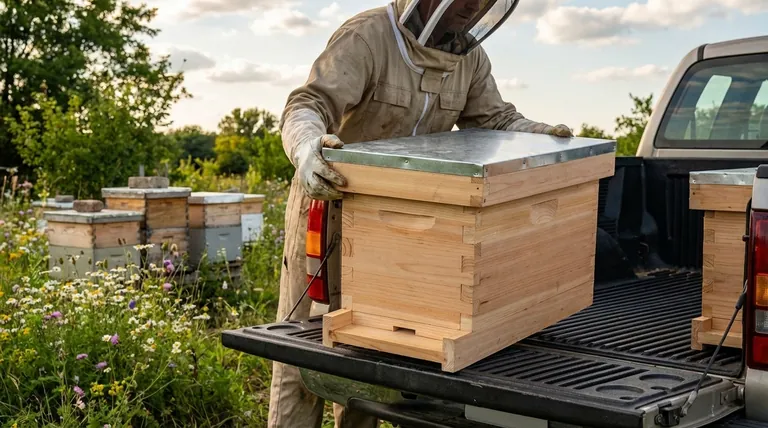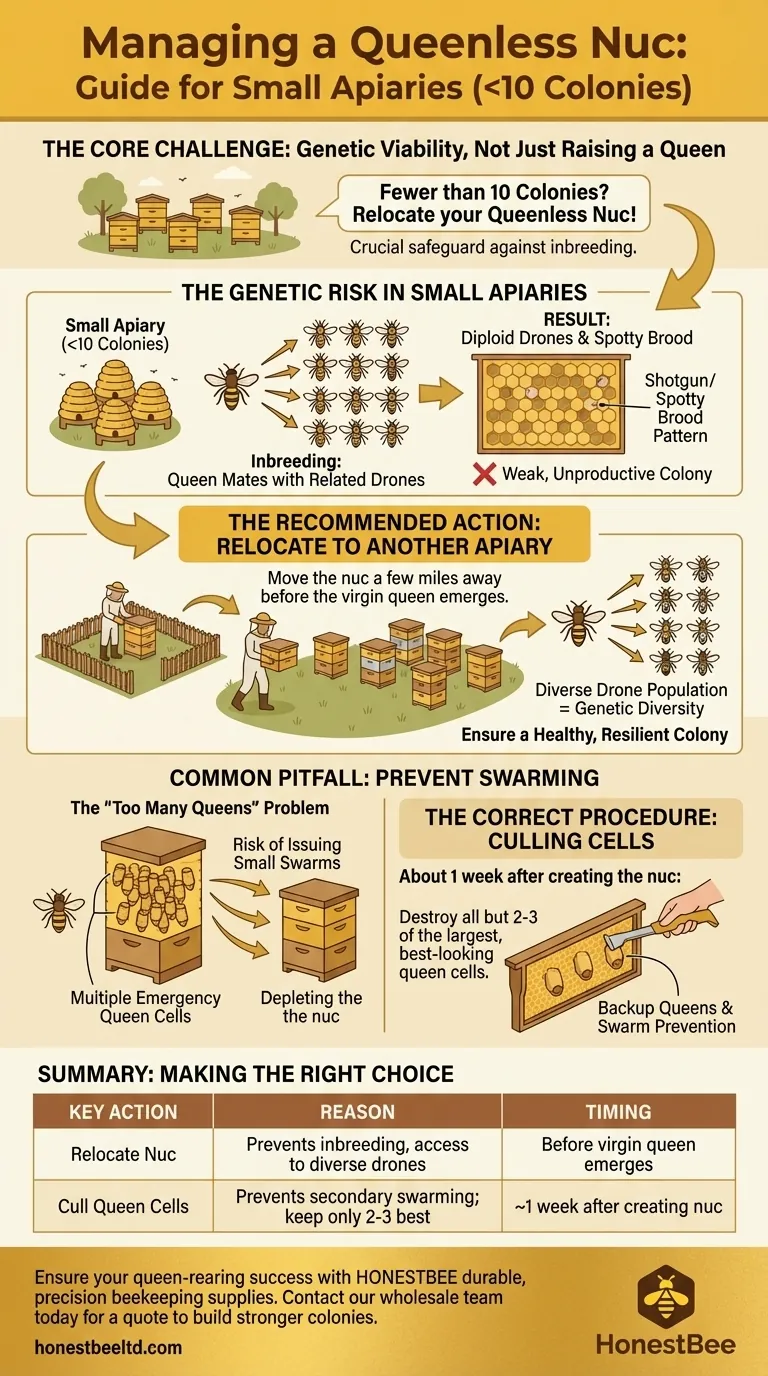For beekeepers with fewer than 10 colonies, the recommended action for a queenless nucleus colony (nuc) is to move it to another beekeeper's apiary. This step is a critical safeguard against inbreeding, which occurs when a new queen mates with related drones from her parent colony. Relocating the nuc ensures she has access to a genetically diverse pool of drones for her mating flight.
The core challenge in a small apiary is not simply raising a new queen, but ensuring her genetic viability. Failing to manage the drone population she mates with can lead to a weak, unproductive colony doomed to fail.

The Genetic Risk in Small Apiaries
To understand the recommendation, you must first understand the biology of honey bee reproduction and the specific risks posed by a small, isolated apiary.
The Queen's Mating Flight
A virgin queen embarks on one or more mating flights shortly after she emerges. She flies to a "drone congregation area" where she will mate with 10-20 drones from various colonies in the surrounding area.
She stores the sperm from these drones for the rest of her life to fertilize eggs. Genetic diversity from multiple mates is essential for the long-term health and resilience of her colony.
The Problem of Inbreeding
When a queen mates with drones she is closely related to (her brothers), it leads to a serious genetic problem.
Fertilized eggs with identical sex alleles produce diploid drones instead of female workers. These diploid drone larvae are identified and consumed by the worker bees shortly after they hatch.
This results in a "shotgun" or spotty brood pattern, with many empty cells where larvae were removed. The colony cannot build its population, becomes weak, and will likely perish.
Why "Fewer Than 10" Is the Guideline
In a small apiary of fewer than 10 colonies, the local drone population is not very diverse. There is a statistically high probability that a new queen will encounter and mate with a significant number of related drones.
By moving the nuc a few miles away, you place it in a completely different mating zone with a new population of unrelated drones, dramatically reducing the risk of inbreeding.
Common Pitfalls to Avoid
Beyond managing genetics, you must also manage the nuc itself to prevent it from swarming. This is a common and costly mistake.
The "Too Many Queens" Problem
When a colony becomes queenless, the workers will create multiple emergency queen cells. If you allow too many of these queens to emerge, their instinct is to swarm.
Leaving four or more queen cells in the nuc makes it highly likely that the colony will issue one or more small swarms, each with a virgin queen. This depletes the nuc of bees and resources, defeating its purpose.
The Correct Procedure for Culling Cells
About one week after you create the queenless nuc, you must intervene.
Carefully inspect the frames and destroy all but 2 or 3 of the largest, best-looking queen cells. This provides a backup in case one queen fails to emerge or is lost on her mating flight, while being a low enough number to prevent swarming.
Making the Right Choice for Your Nuc
Your goal is to produce a healthy, productive colony. That requires managing both the genetic and behavioral risks involved in raising a new queen.
- If you have fewer than 10 colonies: Your top priority is preventing inbreeding, so you must relocate the queenless nuc to another apiary before the virgin queen emerges.
- Regardless of your apiary size: You must cull the queen cells down to the best 2-3 about a week after making the nuc to prevent it from issuing secondary swarms.
By actively managing both genetic diversity and swarm risk, you ensure your new colony has the foundation it needs to thrive.
Summary Table:
| Key Action | Reason | Timing |
|---|---|---|
| Relocate Nuc | Prevents inbreeding by accessing a diverse drone population | Before virgin queen emerges |
| Cull Queen Cells | Prevents secondary swarming; keep only 2-3 best cells | ~1 week after creating nuc |
Ensure your queen-rearing success with the right equipment. For commercial apiaries and distributors managing genetics and colony health, HONESTBEE supplies durable, precision beekeeping supplies in bulk. Let us help you build stronger, more productive colonies. Contact our wholesale team today for a quote to equip your operation for success.
Visual Guide

Related Products
- 5 Frame Wooden Nuc Box for Beekeeping
- Honey Flow Garden Bee Hive Flow Hive Best Beehive for Beginners
- HONESTBEE Professional Multi-Functional Hive Tool with Ergonomic Wood Handle
- HONESTBEE Professional Long Handled Hive Tool with Precision Cutting Blade
- Multi-Function Plier-Style Frame Grip Hive Tool
People Also Ask
- How should the nuc be installed in the apiary? Ensure Colony Success from Day One
- What is the purpose of having a nuc in beekeeping? Build a Resilient & Productive Apiary
- What is a common feature of many 5-frame nuc boxes? The Integrated Feeder for Efficient Colony Growth
- What are the benefits of using nucs for beginning beekeepers? Ensure a Successful First Hive with a Head Start
- How many frames does a typical wooden nuc box hold? A Guide to Choosing the Right Size



















